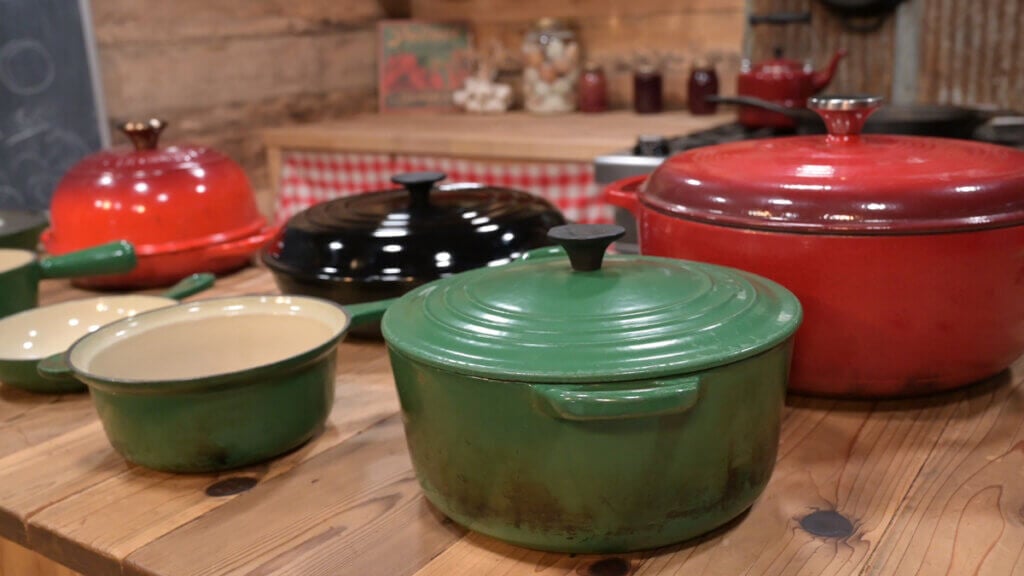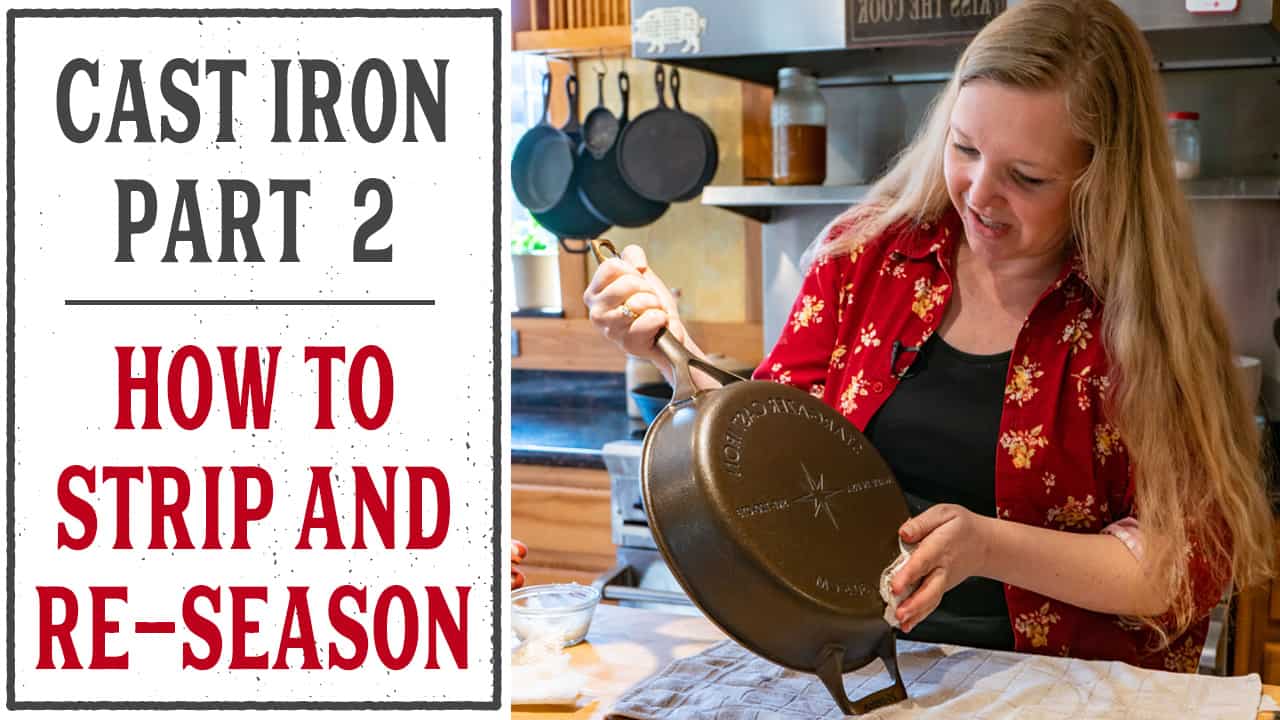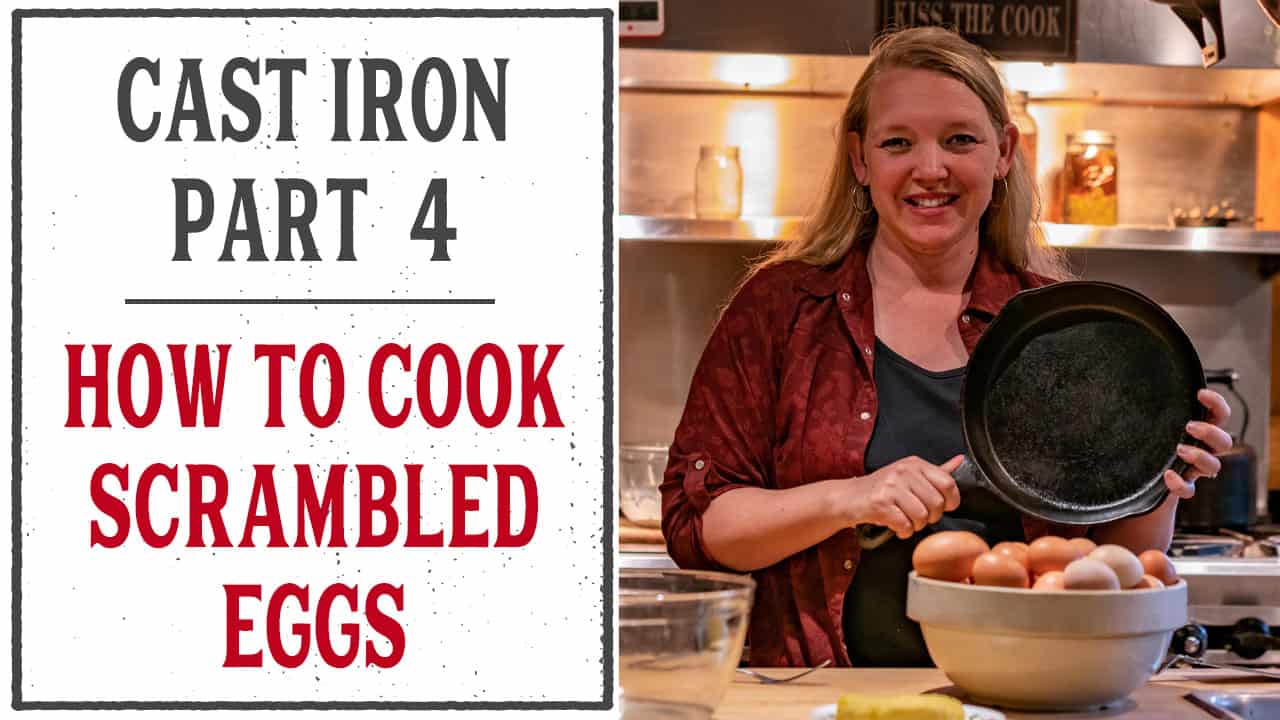
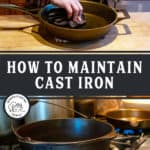





When cast iron is not properly maintained, it will rust, have burnt on food, and be frustrating to work with. However, when you know how to clean a cast iron pan, the non-stick experience is so enjoyable that you will choose cast iron cookware every time you cook. Use this easy tutorial and say goodbye to dirty or rusty cast iron pans forever!

Table of Contents
ToggleThe Importance of Knowing How to Clean a Cast Iron Pan
Once you’ve picked the best cast iron cookware and stripped and seasoned your cast iron pans to perfection, it’s important to know how to clean a cast iron pan to protect all that initial hard work.
Whether it’s regular or enameled cast iron, we love it because it’s so durable that it can be passed down from generation to generation. Unlike other cookware options, regular cast iron allows us to cook on the wood cookstove, conventional oven, BBQ grill, or even over an open campfire.
Additionally, cast iron retains and distributes heat well, making it a superior cooking surface. We can’t ignore the fact that cast iron is an affordable option for a non-stick surface that avoids toxic chemicals.
Did I mention that cast iron is also easy to maintain? While there’s a right way and a wrong way to clean cast iron, knowing the right way will save you a lot of headaches.
This tutorial covers the right way and also shares some things NEVER to do when using cast iron. If you missed any other videos or blog posts in this series, you can check them out below:
Best Foods to Cook in Cast Iron
Once your pans are properly seasoned and you have been cooking on them for some time, you can cook almost anything in them.
The very best food to start cooking with is going to be foods high in fat. My preference is bacon or breakfast sausage. The fat is going to cook out and continue to coat your pan with a nice extra layer of seasoning.
The more you cook in your pans and continue to build up that seasoning, the more you can expand what you cook in your pan.

Why Does Food Stick to My Cast Iron Pan?
If you’re having a hard time with food sticking to your cast iron pan, then either your seasoning isn’t well-developed enough, or you’re not properly cooking in your cast iron.
Most people complain about scrambled or fried eggs sticking horribly. If that’s your struggle, too, check out how to cook scrambled eggs in cast iron. It may be that your seasoning isn’t quite right or that you’re not following the proper cooking methods and temperatures for your pan. I walk you through the process step-by-step so you have delicious, fluffy eggs sliding out of your pan every time.
If you’ve just finished seasoning your cast iron pans, as I recommended above, start by cooking with very fatty items in the pan for a while. Once you have no problems with that item of food sticking, then keep trying new, less fatty foods until you’re cooking without sticking.
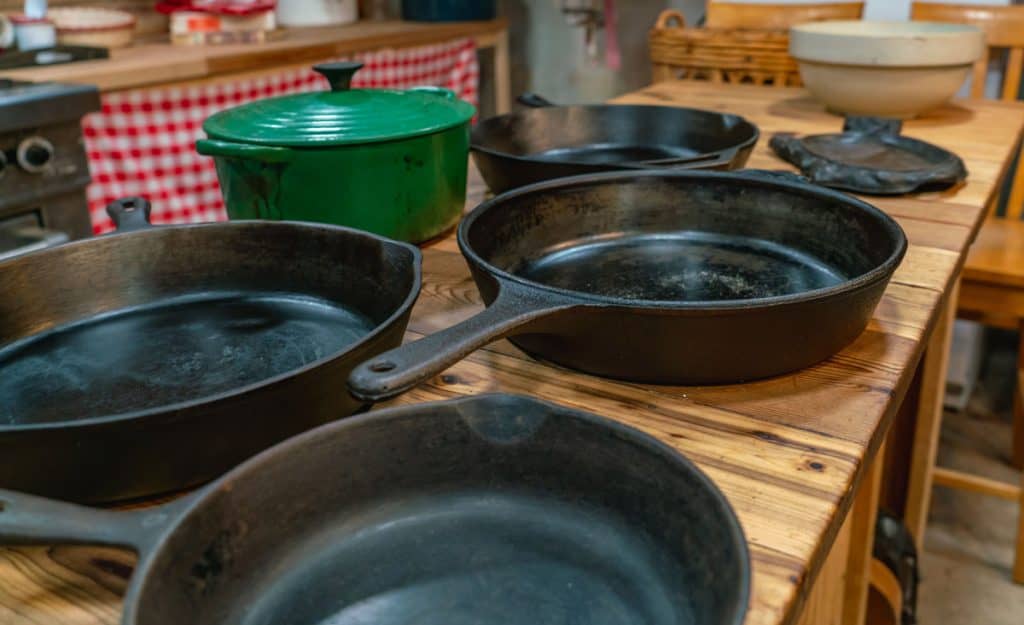
Supplies Needed
- Food Scraper – If you don’t have a food scraper on hand, you can also use a wooden spatula. Check out these beautiful wooden kitchen tools made by our friends at Riverwood Trading Co.
- Pot Holders – It is best to work with your cast iron before it completely cools, so pot holders come in handy to protect yourself from burns.
- Soft Cloth – Never use an abrasive cloth on your pan.
- Oil – When it comes to cast iron, not all oils are created equal. My top choices are extra virgin coconut oil, flaxseed oil (learn to press your own seed oils here), rendered lard or tallow, and avocado oil.


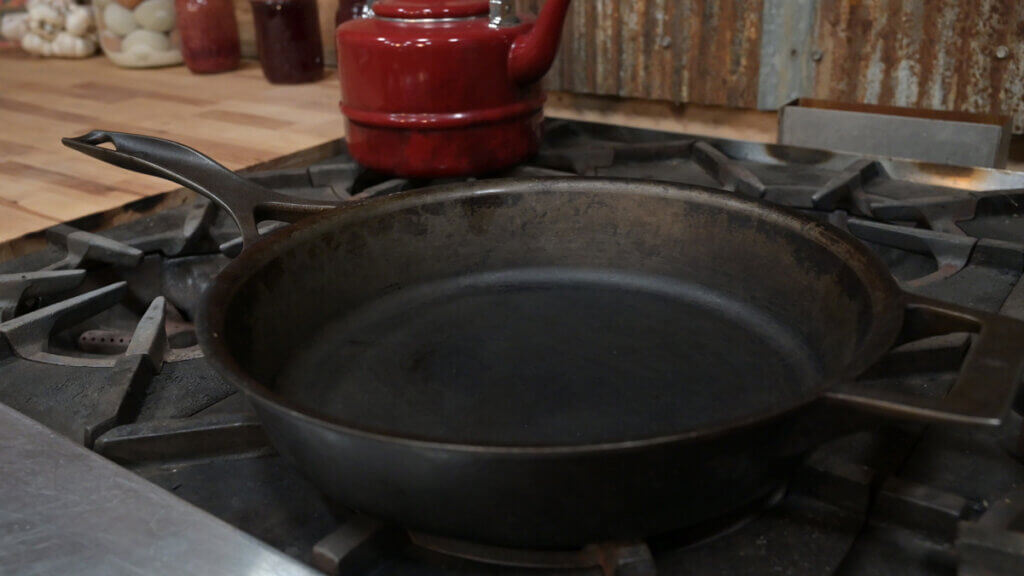
How to Clean a Cast Iron Pan
Cleaning cast iron couldn’t be easier once you get the hang of it. Because it’s slightly different than traditional cookware, it can take a bit of getting used to. But in the end, I find them much easier to care for than stainless steel or other cookware.
- Scrape Off Food – Before the pan cools off, scrape off any remaining food into the trash. This is usually easiest if done while the pan is still hot. Be careful and use pot holders so you don’t burn yourself while doing this step. Also, be careful you’re not scratching the seasoning. Use a flat metal spatula, and don’t dig into the coating. To remove burnt residue, boil water in the pan to loosen it. Then, use a non-metallic scraper to remove it. For tough spots, scrub with kosher salt and water.
- Allow Pan to Cool – Running cold or even warm water over a hot cast iron pan could cause damage, so it’s important to allow it to cool down before cleaning.
- Run Under Hot Water – The hotter the water, the easier your pans are to clean. Run the pan under the hot water and wipe gently with a soft washcloth. No need to use dish soap, a scouring pad or steel wool here, that will just ruin your seasoning. Don’t be concerned about bacteria either, the heating process will kill off any bacteria you may be concerned about.
- Dry Pan Completely – Once the pan is clean, place it back on the burner and turn the heat to medium. Heat the pan until it’s just smoking. This ensures all the water has been evaporated, and you’re no longer at risk of your pans rusting.
- Season – Once the pan is dry, reduce the heat to low and give it a small layer of seasoning. I like to keep a small jar of lard on hand for seasoning, but avocado oil is another great option. Adding a thin layer of fat and heating it causes the oil to adhere to the pan and protect it from humidity during storage. Then, the next time you’re ready to cook, this oil works as a non-stick barrier. If you happen to add too much oil, simply wipe it away with the dry part of your towel or use a clean paper towel to absorb any excess oil.
It is important to note that even the best-seasoned cast iron will have a little bit of sticking from time to time, but the ultimate goal is for your food to cook to perfection and then slide out of the pan with ease. Sometimes food sticks simply because we’re trying to move it (or flip it) too soon.
This is why non-stick cookware became so popular! But the toxins in those pans aren’t worth the convenience, especially when you can achieve that same non-stick coating with cast iron cookware.
Below is a photo of my Stargazer cast iron pan that I love so much. The pan came pre-seasoned (and I added my mandatory extra layer or two of seasoning once I got it out of the box), and it’s been cooking eggs like a charm since day one.
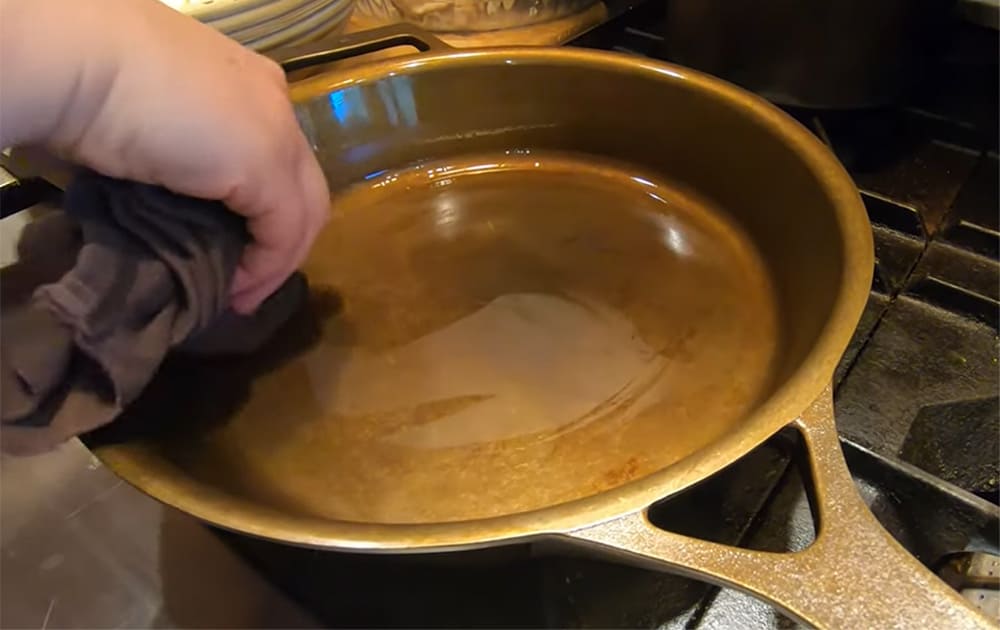
How to Remove Rust From Cast Iron
Don’t worry if you find a spot of rust on your cast iron. It’s not the end of the world. Start by gently scrubbing with fine steel wool. This method removes surface rust without harming the pan.
For deeper rust, try a vinegar soak. Mix equal parts water and white vinegar and soak the pan for an hour. Then, scrub with fine steel wool. The mix should help loosen the rust, making it easier to remove.
After removing the rust, wash the pan with warm soapy water. Dry it well on the stovetop to stop new rust from forming. Then, follow the steps in my tutorial on seasoning a cast iron pan to restore the seasoning.
Believe it or not, I was able to restore the cast iron pan in the photo below!
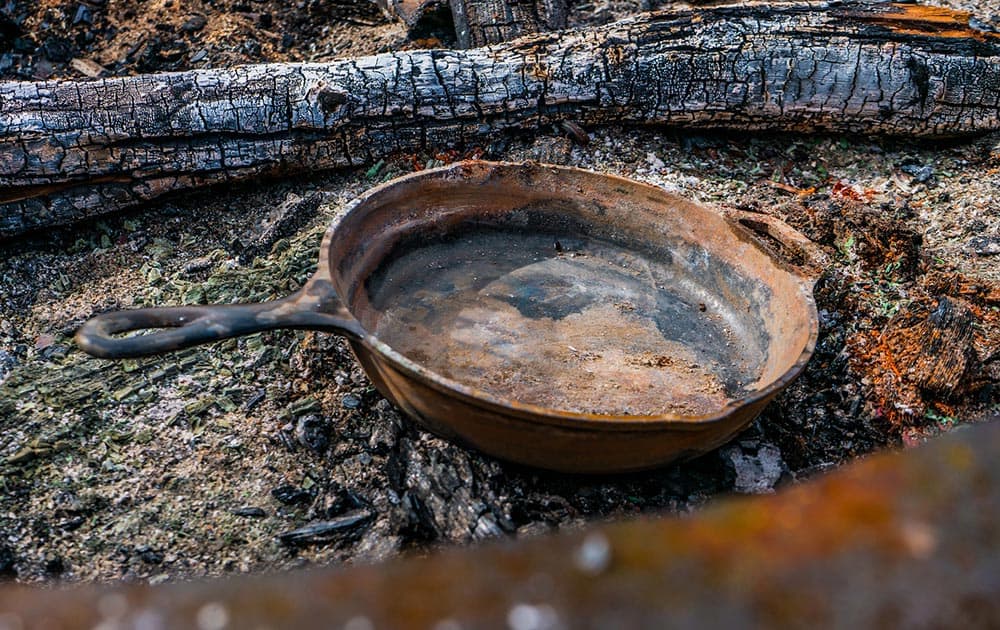
Things NEVER to Do When Cleaning Cast Iron
As I mentioned before, learning how to clean a cast iron pan is easy when you know what to do, but knowing what NOT to do can also be very helpful. Here are six things to NEVER do when cleaning cast iron:
- Avoid Warping Your Pan – Never take hot cast iron and run it under water. It doesn’t matter if it’s hot or cold water, there’s a high possibility of warping or cracking your cast iron pans.
- Resist Soaking Your Pans – Soaking cast iron pans in water is just a recipe for ruining your seasoning and inviting rust.
- Don’t Use the Dishwasher – Never put your cast iron skillet in the dishwasher. It will ruin the seasoning and leave you with a rusty mess.
- Use the Proper Tools – Don’t use any abrasive materials when cleaning your cast iron. Avoid using steel wool or harsh cleaners. These can scratch and remove the seasoning, making the pan less effective and more likely to stick. If you follow proper seasoning, cooking and cleaning practices, anything other than a soft rag should be all you need.
- Proper Drying – Never let your cast iron air dry. Again, this is just an invitation for rust.
- Proper Storage – Don’t store your cast iron unprotected. Always add that extra layer of oil prior to storing. Your future self will thank you. If you’re stacking pans, it’s also advisable to add a layer (such as a kitchen towel or paper towel) between each layer.
With these tips (and my other cast iron tutorials), you’ll be cooking in cast iron like a pro in no time.

FAQ
Before the pan cools off, scrape off any remaining food into the trash. This is usually easiest if done while the pan is still hot.
To remove rust, start with a gentle scrub using fine steel wool. For more rust, soak the pan in a vinegar and water mix for an hour. Then, scrub it again. Don’t neglect to finish the process by learning how to clean your cast iron pan properly in this tutorial.
Avoid harsh cleaners, steel wool, and dishwashers. These can damage the seasoning and cause rust. Bleach and oven cleaners are too harsh, and soaking too long can also cause rust. A soft cloth and hot water is all you should need.
Never put cast iron in the dishwasher or soak it in water. Avoid extreme temperature changes and harsh cleaners or metal scouring pads. Always let the pan cool before washing to prevent damage. Check out more tips listed in this tutorial.
Follow the steps in stripping and seasoning a cast iron pan to bring old, neglected cast iron pans back to life.
For enameled cast iron, use warm water, mild dish soap, and a soft sponge. Avoid metallic pads or harsh chemicals. For tough stains, use a baking soda and water paste. Dry well after washing to keep the coating intact.
